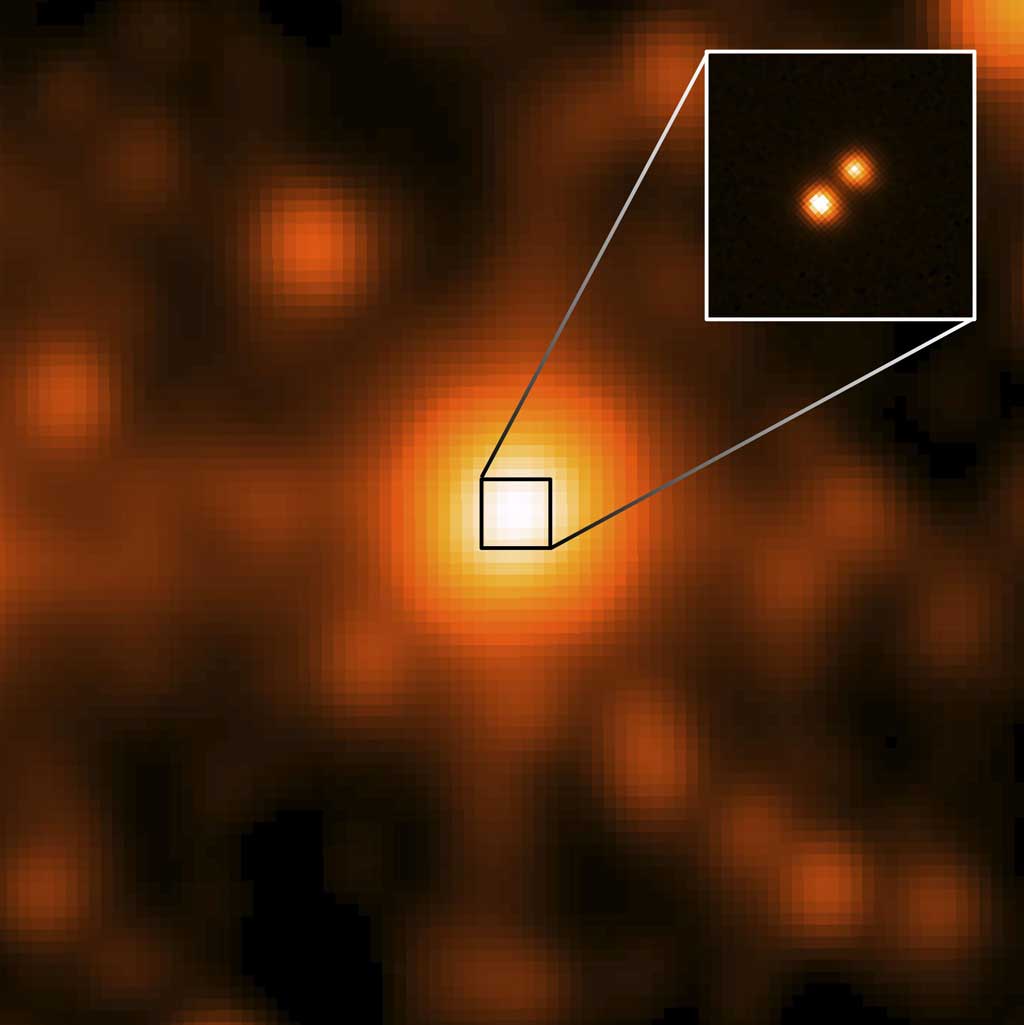Brown dwarfs are essentially failed stars. They lack enough mass for gravity to trigger the nuclear reactions that make stars shine. The newly discovered brown dwarf, identified as CFBDSIR 1458+10B, is the dimmer member of a binary brown dwarf system located 75 light-years from Earth.
The powerful X-shooter spectrograph on ESO’s VLT was used to show that the composite object was cool by brown dwarf standards. “We were very excited to see that this object had such a low temperature, but we couldn’t have guessed that it would turn out to be a double system and have an even more interesting, even colder component,” said Philippe Delorme from the Institut de planétologie et d’astrophysique de Grenoble, France. CFBDSIR 1458+10 is the coolest brown dwarf binary found to date.
The dimmer of the two dwarfs has been found to have a temperature of about 212° Fahrenheit (100° Celsius) — the boiling point of water, and not much different from the temperature inside a sauna. “At such temperatures, we expect the brown dwarf to have properties that are different from previously known brown dwarfs and much closer to those of giant exoplanets — it could even have water clouds in its atmosphere,” said Michael Liu from the University of Hawaii’s Institute for Astronomy. “In fact, once we start taking images of gas giant planets around Sun-like stars in the near future, I expect that many of them will look like CFBDSIR 1458+10B.”
Unraveling the secrets of this unique object involved exploiting the power of three different telescopes. CFBDSIR 1458+10 was first found to be a binary using the Laser Guide Star (LGS) Adaptive Optics system on the Keck II Telescope in Hawaii. Liu and his colleagues then employed the Canada–France–Hawaii Telescope, also in Hawaii, to determine the distance to the brown dwarf duo using an infrared camera. Finally the ESO VLT was used to study the object’s infrared spectrum and measure its temperature.
The hunt for cool objects is an active astronomical hot topic. The Spitzer Space Telescope has recently identified two other faint objects as other possible contenders for the coolest known brown dwarfs, although their temperatures have not been measured so precisely. Future observations will better determine how these objects compare to CFBDSIR 1458+10B. Liu and his colleagues are planning to observe CFBDSIR 1458+10B again to better determine its properties and to begin mapping the binary’s orbit, which, after about a decade of monitoring, should allow astronomers to determine the binary’s mass.
Brown dwarfs are essentially failed stars. They lack enough mass for gravity to trigger the nuclear reactions that make stars shine. The newly discovered brown dwarf, identified as CFBDSIR 1458+10B, is the dimmer member of a binary brown dwarf system located 75 light-years from Earth.
The powerful X-shooter spectrograph on ESO’s VLT was used to show that the composite object was cool by brown dwarf standards. “We were very excited to see that this object had such a low temperature, but we couldn’t have guessed that it would turn out to be a double system and have an even more interesting, even colder component,” said Philippe Delorme from the Institut de planétologie et d’astrophysique de Grenoble, France. CFBDSIR 1458+10 is the coolest brown dwarf binary found to date.
The dimmer of the two dwarfs has been found to have a temperature of about 212° Fahrenheit (100° Celsius) — the boiling point of water, and not much different from the temperature inside a sauna. “At such temperatures, we expect the brown dwarf to have properties that are different from previously known brown dwarfs and much closer to those of giant exoplanets — it could even have water clouds in its atmosphere,” said Michael Liu from the University of Hawaii’s Institute for Astronomy. “In fact, once we start taking images of gas giant planets around Sun-like stars in the near future, I expect that many of them will look like CFBDSIR 1458+10B.”
Unraveling the secrets of this unique object involved exploiting the power of three different telescopes. CFBDSIR 1458+10 was first found to be a binary using the Laser Guide Star (LGS) Adaptive Optics system on the Keck II Telescope in Hawaii. Liu and his colleagues then employed the Canada–France–Hawaii Telescope, also in Hawaii, to determine the distance to the brown dwarf duo using an infrared camera. Finally the ESO VLT was used to study the object’s infrared spectrum and measure its temperature.
The hunt for cool objects is an active astronomical hot topic. The Spitzer Space Telescope has recently identified two other faint objects as other possible contenders for the coolest known brown dwarfs, although their temperatures have not been measured so precisely. Future observations will better determine how these objects compare to CFBDSIR 1458+10B. Liu and his colleagues are planning to observe CFBDSIR 1458+10B again to better determine its properties and to begin mapping the binary’s orbit, which, after about a decade of monitoring, should allow astronomers to determine the binary’s mass.










